Poison Dart frogs are one of nature’s most fascinating creatures. These amphibians have evolved an amazing array of defenses to help them survive in the wild, including some truly bizarre adaptations.
Their brilliant camouflage coloration, high toxic skin, outstanding vision, excellent climbing ability, ultra sticky tongue, frequent breeding, and tiny size make them highly adaptable in South America’s fertile and dense rainforest.
Here, in the following part, you will see all of those amazing adapting abilities of the poison dart frog.
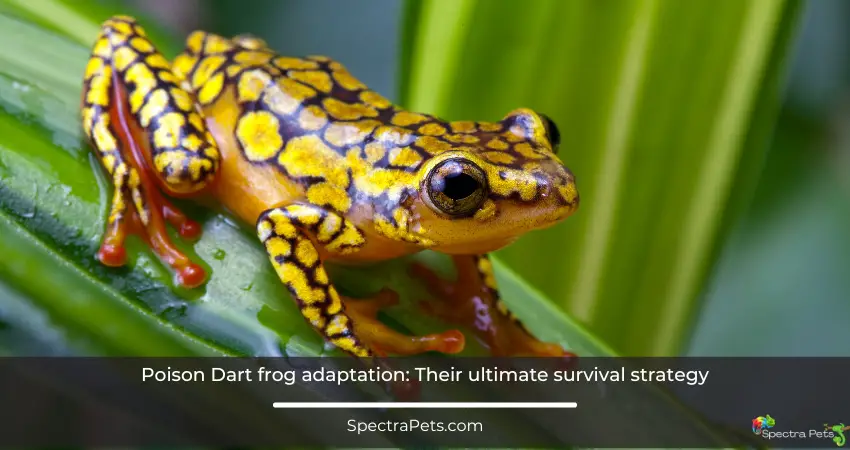
Poison dart frog adaptations: [Physical Attributes Explained]
In terms of adaptation, poison dart frogs are the masters of the rainforest. These tiny Amphy fiends survive in the South American forest like a legend. Compared to other frogs these frogs are much ahead in the survival game. And full credit goes to the intelligent body settings that help them eat most while escaping the predator excellently.
Let’s explore the physical attributes that give them high-level adaptivity in nature…
Camouflage skin color
Dart frogs come in various colors, from bright reds to vibrant greens. While the colors may seem like nothing more than aesthetic choices, they play an important role in the frog’s survival.
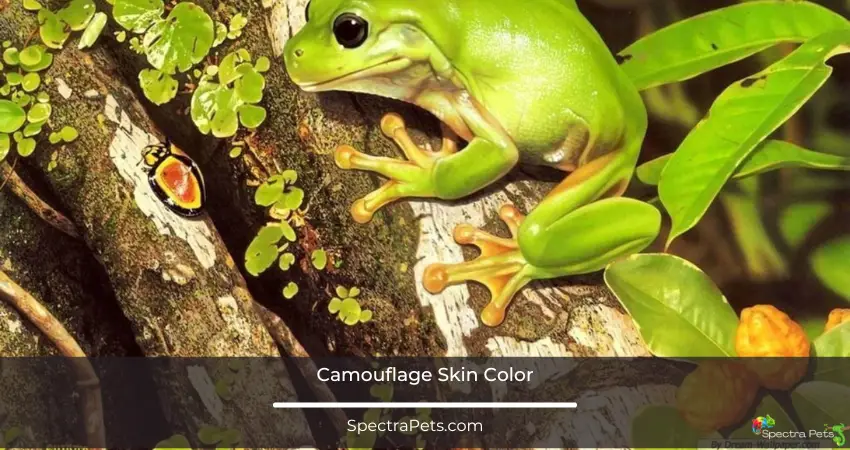
The right color can help the frog blend in with its surroundings, making it harder for predators to spot. In some cases, the poison dart frog’s skin may mimic the leaves or bark’s texture, furthering its camouflage.
Excellent climbing ability
One of the fascinating aspects of nature is the way that different animals have adapted to their environments. Look at the poison dart frog. These small amphibians are found in the rainforests of Central and South America, where they spend most of their time in the trees.
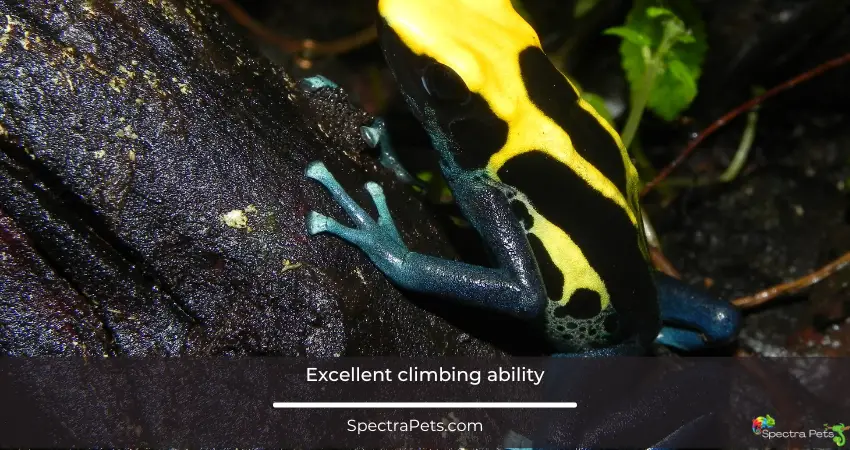
The dart frog’s sticky feet are perfectly adapted for climbing, allowing them to move effortlessly from branch to branch. In addition to helping the frogs stay safe from predators, this ability also allows them to find food and mate with other frogs. As a result, the sticky feet of dart frogs play a vital role in their survival.
Small size
Poison dart frogs are some of the smallest amphibians in the world, with some species measuring less than an inch in length. The frogs’ small size gives them several advantages when it comes to evading predators. For one thing, they can more easily find hiding places.
And if they are spotted by a predator, their tiny size makes them more difficult to catch. In addition, poison dart frogs can use their small size to their advantage when it comes to escape.
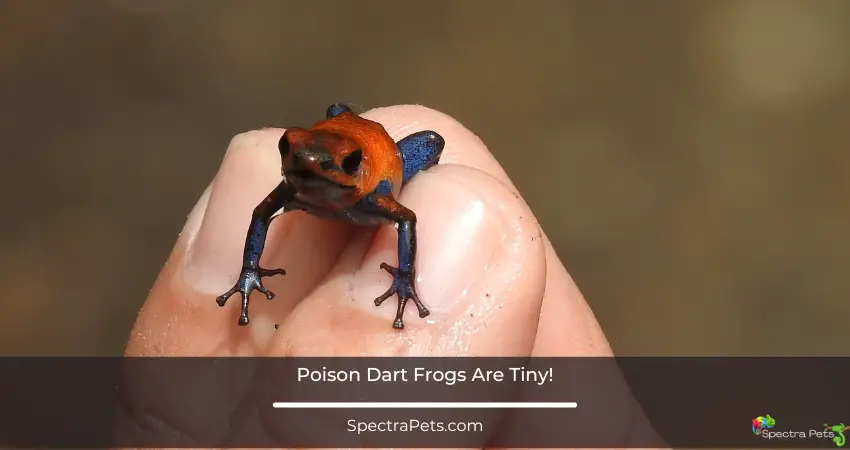
Moreover, their nimble bodies and long legs allow them to quickly hop away to safety. Thanks to their diminutive size, dart frogs have evolved into skilled survivors in the animal kingdom.
Toxic loaded skin
Dart frogs are some of the most beautiful creatures in the forest. But their beauty is not just skin deep – they also possess a very unique defense mechanism. Poison dart frogs secrete a toxin from their skin that is so potent that it can kill predators that try to eat them.
This toxin makes the dart frog one of the most feared creatures in the Forest, and it allows them to live relatively safely among their predators. The dart frog’s toxicity is just one example of how these animals have adapted to their environment.
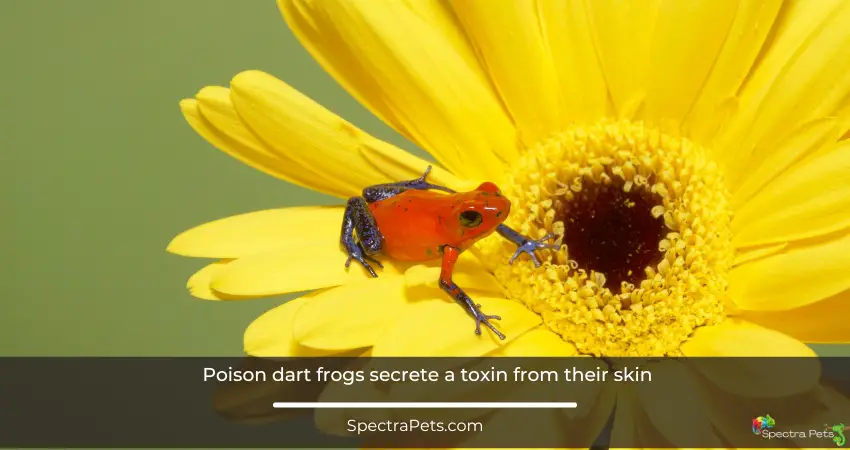
As a result, the dart frog has thrived in the forest for centuries, and it shows no signs of disappearing any time soon.
Frequent breeding
Poison Dart frogs play an important role in the ecosystem. One of the most notable things about dart frogs is their breeding habits. Unlike many other animals, dart frogs breed throughout the year. This constant reproduction helps to ensure that the population remains healthy and robust.
In addition, dart frogs often produce large clutches of eggs, which gives them a greater chance of success in propagating their species.
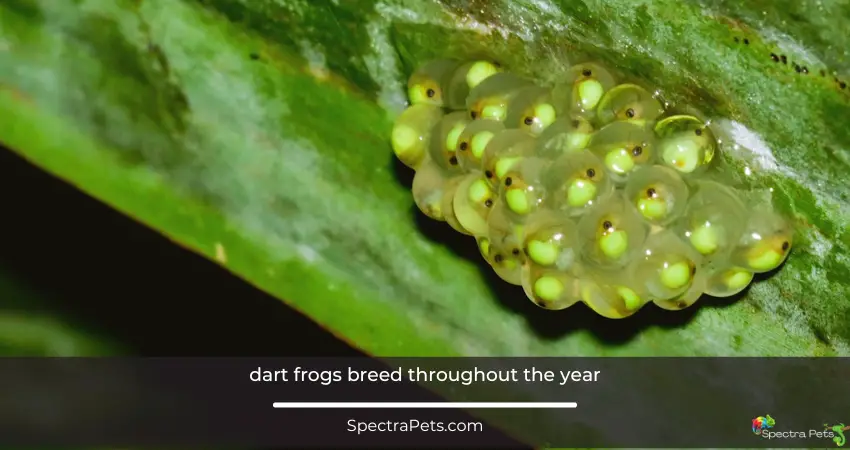
By comparison, animals that only breed seasonally often have a smaller litter and face more significant challenges in population growth. As a result, dart frogs play an important role in maintaining the health of rainforests.
How to take care of dart frog eggs and tadpoles? [Read More]
Outstanding communication among the species
These tiny amphibians are well known for their brightly colored bodies, which can be orange, yellow, green, or blue. They use their vibrant colors to communicate with each other.
For example, orange and yellow frogs typically want to avoid contact with each other, while green and blue frogs often signal that they are ready to mate.
In addition to visual cues, Poison dart frogs also use vocalizations to communicate. Males will croak to attract mates, while females will make chirping sounds when they are ready to lay eggs. By communicating with each other, dart frogs can survive in the dense rainforest environment.
Sticky Tongue
Poison Dart frogs are quite successful hunters. One reason for this is their sticky tongue. When a dart frog sees its prey, it flicks out its tongue with lightning speed. The tongue then wraps around the prey and pulls it back into the frog’s mouth. Thanks to this amazing hunting technique, poison dart frogs can catch a wide variety of small insects and animals.
In addition to the special preying strategy, this guy also has an extraordinary vision with eyes positioned on either side of their head, giving it a wide field of view.
Also, these eyes are specially adapted to see in low light conditions, making them perfectly suited for hunting at night. So, this avid hunter is capable of spotting potential prey from a distance, tracking its movements easily, and capturing the prey with ease in order to ensure a steady supply of food.
Final words
Now you know why Poison Dart frogs have been ruling the rainforest at their food chain level. While they enjoy a large number of insects, they save themselves from the hunters of a higher food chain and continue to produce offspring.
All including these mind-boggling colorful frogs are just one hell of a creature that deserves to survive like that.
I hope you got an overall idea about poison dart frogs’ adaptation in the natural habitat.

As a zoology student, I read this post. It has useful information that will assist me with my assignment. Thank you for sharing such useful information.